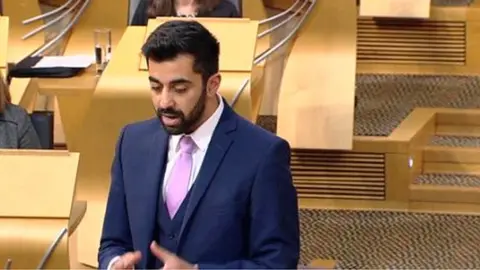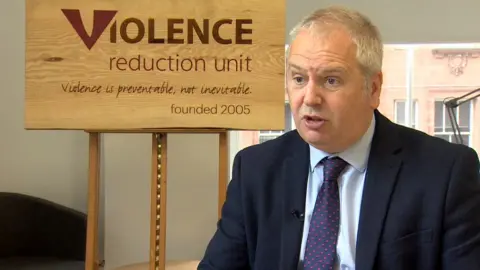Violent crime in Scotland rises to highest level in seven years
 Getty Images
Getty ImagesViolent crime in Scotland has risen by 10% in the year to last March, official figures have revealed.
It is the highest level for seven years, with a 16% rise in robberies.
Scotland's Violence Reduction Unit (VRU) said robbery was a crime of desperation and the rise could reflect deprivation in some communities.
Sexual crimes, including rape, rose to the highest level ever recorded - an 8% increase - with many historical offences included in the total.
Scotland's annual crime figures have been released by the Scottish government.
The Recorded Crime in Scotland bulletin for 2018 - 2019 stated that overall crime rose by 1% to just under a quarter of a million offences.
The number of crimes reported was 246,480.
The report said the recording of crime remained at one of the lowest levels seen since 1974 and the police clear-up rate rose to 51%, one of the highest levels since comparable records began in 1976.
The statistics also demonstrated a drop in some areas of criminal activity.
Crimes of dishonesty remained almost unchanged, with fireraising and vandalism falling by 6%. "Other crimes" - mostly relating to drug possession, crimes against public justice, or handling offensive weapons, increased by 6%.
Fraud crimes were most commonly related to fraudulent use of bank cards, failure to pay for products or services, fraudulent selling and phishing-type frauds with an estimated 28% of these offences internet-based.
As a result of the rise in violent crime, Justice Secretary Humza Yousaf has launched a study into people who experience repeat incidents of violence.
An extensive 16-month research project will engage with victims of violent crime, particularly in Scotland's most disadvantaged communities, and those facing challenges from homelessness, substance misuse or previous convictions.

What is Repeat Violent Victimisation?
 Getty Images
Getty ImagesBy Reevel Alderson, BBC Scotland's Home Affairs Correspondent
The level of violent crime in Scotland, excluding sexual offences, has been broadly stable in recent years although the figures for 2018/19 do show a significant rise over the previous 12 months.
What has been concerning ministers is the surprising fact that many victims suffer violence more than once - known as repeat violent victimisation (RVV).
The Scottish Crime and Justice Survey covering 2017/18 suggested more than half of the victims of violent crime (59%) suffered repeat victimisation.
On average, they had each experienced three violent crimes - although a small proportion experienced five or more incidents.
The Scottish government has now commissioned research to improve its understanding of RVV and help drive further reductions in violent crime.
The situation is not unique to Scotland: evidence from national and international crime surveys shows violent crime is disproportionately suffered by repeat victims.
The 2018 Crime Survey for England and Wales (CSEW) has broken down RVV by the type of offence.
Unsurprisingly, 34% of domestic violence victims were attacked more than once.
A review of evidence by the Scottish government's Safer Communities Directorate published in April 2019 examined the main reasons for RVV.
"Being victimised once can change individuals or their circumstances in ways that increase the risk of being victimised again," the report said.
It said a violence reduction strategy should concentrate on enhancing the safety and protection of victims after the first violent offence - but it admitted this had yet to happen.
The government review suggested victims of RVV were often young, male - except in the case of domestic violence - and from deprived backgrounds.
But it said there was a lack of specifically Scottish evidence, which was why the government is commissioning new research.

Mr Yousaf said: "While there is less crime and fewer victims than a decade ago, the impact on victims, particularly of sexual or violent crimes, is often devastating. That is why we are strengthening how Scotland's justice system and other public services support victims, while investing in both law enforcement and crime prevention projects.
"We want victims to have the confidence to report crimes to the police, We know that many of the sexual crimes recorded in this year's figures occurred many years in the past. We are investing record levels of funding to support victims through a range of frontline specialist services."

He added: "I have commissioned a major study into repeat violent victimisation. While fewer than 1 in every 100 adults are victims of repeated incidents of violence, these accounted for around three-fifths of violent crime.
"This research will help police, together with local and national government to better understand the nature of repeat violence - including the role of substance misuse - and ensure we focus our efforts on those most affected by violence wherever it persists."
Niven Rennie, director of the VRU, said: "Robbery is a crime of desperation and tends to happen to feed a drug habit, and we see allied to that an increase in drug deaths, drug seizures, and a recognition that Scotland has a problem.
"We've seen a plateauing in the last 10 years. We are seeing violence happening in communities which haven't seen a decrease in violence that others have. Areas with high levels of alcohol intake, drug abuse. We need to look at these wider social issues."

Deputy Chief Constable Malcolm Graham, from Police Scotland, said: "Police Scotland cleared up an additional 89 crimes per week on average compared to the year before and increased detection rates are to be welcomed.
"We have seen a large increase in reports of rape and sexual offences since the formation of Police Scotland. It is crucial those affected by these crimes feel confident about coming forward and reform of policing has transformed how we approach these cases."
A separate report released to coincide with the new recorded crime figures, "Non-sexual violence in Scotland", outlines that the overall fall in violence over the past decade has been driven by a reduction in younger men's involvement.
It also highlights that violent crime remains commonly associated with alcohol, drug use, more deprived areas and repeat victimisation.
